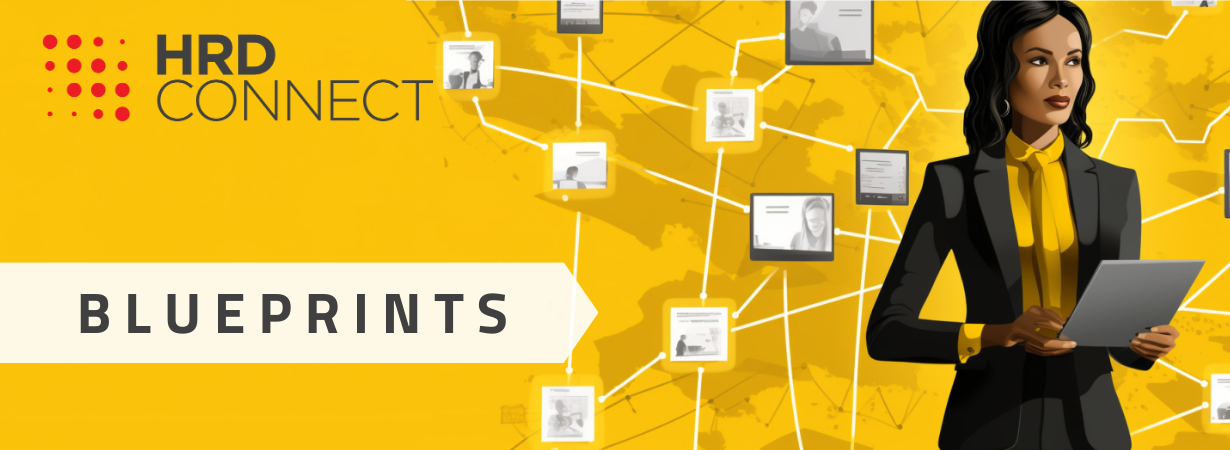Blueprint: How to build a global leadership network for cross-location learning
- 9 Min Read
This blueprint provides HR leaders with a structured approach to craft a global leadership network, facilitating cross-location learning and leadership development. Use this roadmap to establish a network that enhances knowledge-sharing, fosters collaboration, and addresses the unique challenges posed by geographical and cultural differences.
- Author: HRD Connect
- Date published: Nov 1, 2023
- Categories

In an era of re-globalization, there is a mounting necessity to ensure consistent leadership practices and knowledge sharing, irrespective of location. While the benefits of global operations are many, they come with the challenge of ensuring unified leadership standards and practices across varying cultures and business environments. A global leadership network for cross-location learning addresses this challenge head-on.
By connecting leaders from different geographical locations, it fosters a culture of shared learning and mutual growth. Leaders get an opportunity to understand diverse business landscapes, share success stories, learn from challenges, and together, build a cohesive leadership strategy that is globally aligned yet locally relevant. This blueprint outlines a systematic approach to building such a network, ensuring that it not only bridges the knowledge gap but also enhances the quality of leadership across your organization.
Step 1: Setting the groundwork
Start by diving into the current leadership landscape across your organization. Look at leadership programs you have in place and find areas or teams where there’s a gap in leadership knowledge or styles. Discover any communication issues, cultural differences, or other barriers that might be there. Your aim is to see where a global leadership network can fill these gaps and bring uniform leadership practices.
Set clear goals for your global leadership network. What do you want to achieve? Is it to bring consistent leadership practices, boost teamwork across regions, or share knowledge? Having clear goals will guide your next steps and make sure everything aligns.
Figure out who will drive this initiative and who will take part in it. You might want to involve regional leadership teams, HR experts, or even outside experts who know about global leadership challenges.
Finish this step by making a detailed roadmap. This should map out the journey from start to finish, with clear steps, timelines, and responsibilities. A clear plan will keep everything on track and make sure everyone knows what they should be doing.
- Why it matters: Getting this first step right is key. It makes sure the global leadership network isn’t just a short-term project but a lasting strategy to boost leadership quality and teamwork across the board.
- How to execute: Start with surveys or interviews of current leadership programs. Hold workshops with key people to set goals. Make a clear plan with steps, dates, and responsibilities.
- Who to engage: Bring in regional leadership teams, HR experts, and even external consultants with a knack for global leadership.
- Tools and resources: Use survey tools to gather feedback on current leadership practices. Use planning software to lay out each step of your plan.
Step 2: Designing the global leadership network
Dive into the structure and format of the network. Consider factors like the frequency of interactions, whether the network will operate more as a formalized mentoring program or as a loose collaboration forum, and the types of technologies or platforms that can best support its operations. Depending on the organization’s spread, you might even contemplate regional hubs or chapters to ensure more localized and efficient interactions.
Next, lay down clear roles and responsibilities. Who will lead regional or chapter meetings? Who will be responsible for sharing insights, and how often? It’s crucial to create a sense of ownership among the participants.
Communication is the backbone of a global network. Select robust communication channels. Will there be a dedicated intranet portal? Periodical newsletters? Regular video conferences? Choose platforms that cater to diverse time zones and languages to ensure inclusivity.
Having clear guidelines and policies will make sure the network runs smoothly. These might touch upon aspects like the frequency of knowledge sharing, the confidentiality of shared insights, and codes of conduct during interactions.
With a solid design, a framework for continuous knowledge-sharing and learning activities will naturally evolve. These could range from webinars, workshops, and peer mentoring sessions, to even international leadership conferences.
- Why it matters: A well-structured network facilitates effective collaboration and ensures that learning and knowledge sharing are consistent and impactful.
- How to execute: Collaborate with IT and communications teams to establish robust platforms. Workshop with leadership teams across regions to understand their unique needs and adapt the design accordingly.
- Who to engage: Engage IT experts for technology deployment, communication teams for setting up channels, and leadership teams across regions for inputs.
- Tools and resources: Collaboration tools, portals for content sharing, and webinar platforms for online workshops and learning sessions.
Step 3: Recruitment and selection
Begin by identifying potential leaders from various locations and hierarchies. To create a dynamic network, you’ll want to blend seasoned leaders with emerging talent, ensuring a mix of experience, fresh perspectives, and varying leadership styles.
Promote the benefits of joining the network to potential participants. Emphasize the value of cross-regional learning, the opportunity to mentor and receive mentorship, and the prospects of gaining global insights that can propel their own leadership journeys.
A successful global leadership network is as much about skills as it is about attitude. Gauge the adaptability, cultural sensitivity, and global outlook of potential participants. Consider using behavioral interviews or psychometric tests to get insights into these competencies.
The selection process should prioritize diversity and inclusion. By ensuring representation from various genders, ethnicities, and professional backgrounds, you will enrich the learning environment and ensure a multitude of perspectives.
Conclude the recruitment process by formally inducting the selected participants. Establish expectations, share the roadmap, and foster an environment where they feel empowered to contribute and learn.
- Why it matters: Who you bring into the network will define its effectiveness. A diverse, skilled, and engaged group ensures vibrant discussions, varied learnings, and a resource-rich environment.
- How to execute: Use existing HR databases to identify potential candidates, hold informative sessions about the network, and follow a structured assessment process.
- Who to engage: Collaborate with regional HR teams for candidate identification, involve diversity and inclusion experts, and consult with current leadership to identify potential future leaders.
- Tools and resources: Use HRMS systems to identify potential candidates, behavioral assessment tools for gauging competencies, and online platforms for conducting informative sessions.
Step 4: Implementing the global leadership network
With the groundwork in place, it’s time to activate the global leadership network. Begin by conducting a comprehensive orientation program for the selected participants. This orientation should impart a clear understanding of the network’s objectives, its functioning, and the expectations from each member.
Communication is the backbone of a global network. Establish robust channels that facilitate easy and effective communication across time zones. Consider platforms that offer video conferencing, collaborative tools, and instant messaging capabilities.
Regularly schedule events like workshops, webinars, and seminars, focusing on global leadership challenges and their solutions. Such events not only offer learning opportunities but also foster interactions and strengthen the bonds between members.
Knowledge sharing is pivotal. Create a digital repository where members can share case studies, research papers, and best practices. This will serve as a dynamic resource, continuously updated with the latest in leadership strategies from around the world.
Change, even if positive, often meets resistance. Address any challenges or apprehensions from within the organization. Continuously communicate the benefits and successes of the network to keep the momentum going and ensure organization-wide buy-in.
- Why it matters: A well-implemented network maximizes engagement and facilitates genuine cross-location learning, driving its overall success.
- How to execute: Organize a thorough onboarding process, invest in top-tier communication tools, and maintain a regular calendar of events. Ensure the availability of resources and platforms for sharing insights.
- Who to engage: Collaborate with IT teams for technological setups, involve leadership coaches or mentors for sessions, and engage with an internal communications team to promote the network’s activities.
- Tools and resources: Use communication platforms like Zoom or Microsoft Teams, set up a knowledge management system or intranet for document sharing, and consider using event management software for scheduling and tracking participation.
Step 5: Continuous monitoring and enhancement
As with any strategic initiative, the journey doesn’t end once the global leadership network is up and running. Continuous oversight ensures the network remains relevant, effective, and aligned with evolving organizational objectives.
Start by monitoring the interactions within the network. Measure the frequency of communication, attendance at events, and the utilization of shared resources. These metrics provide insight into the engagement and vitality of the network.
Gather regular feedback from participants. Understand what’s working, what isn’t, and where there might be room for improvement. Periodic surveys or feedback sessions can shed light on areas that may require intervention.
Analyze the direct impact of the network on leadership development. Are leaders who participate in the network showing marked improvement in their skills? Are they more adept at cross-location collaboration? Evaluative metrics can be established to gauge these outcomes.
Lastly, continuously look outward. The world of leadership is dynamic, with new challenges and solutions emerging regularly. Ensure that the network is always abreast of the latest in global leadership trends and strategies.
- Why it matters: Ongoing monitoring and enhancement ensure the network’s longevity, relevance, and ability to deliver tangible benefits to its participants.
- How to execute: Implement regular check-ins, conduct feedback sessions, and leverage analytics tools to measure participation and engagement. Stay informed about global leadership trends.
- Who to engage: Regularly connect with network members, involve HR analytics teams for insights, and consider external leadership experts for a fresh perspective.
- Tools and resources: Use feedback tools for gathering insights, analytics platforms to measure engagement, and industry journals or platforms for staying updated on leadership trends.
Future focus: Global leadership networks
As we move forward, the dynamics of global leadership networks will inevitably shift. It’s essential to remain adaptable, particularly with the fast-paced advancements in technology. Tools that facilitate global collaboration, like advanced video conferencing or intuitive project management software, will become more refined and could redefine how leadership networks communicate and operate.
Another focal point will be the rise of new leadership paradigms driven by generational changes and varying global priorities. Understanding these shifts, respecting regional differences, and ensuring that the global leadership network remains inclusive and diverse will be crucial. Regular training and workshops will be vital in keeping everyone aligned and updated.
Lastly, while building and refining the network, it’s essential not to lose sight of the primary objective: fostering a culture of shared learning and growth. The essence of these networks is the human connection. Continuous feedback, regular evaluations, and an open channel for communication will ensure the network remains responsive and effective in its mission.









